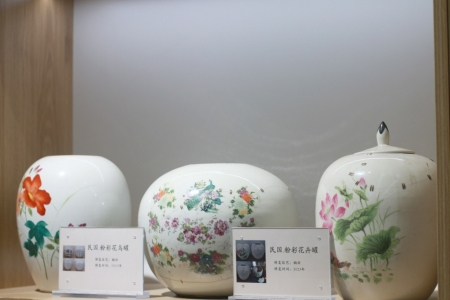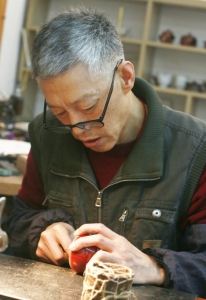Craftsman in SW China's Sichuan dedicated to porcelain mending
From:People's Daily OnlineAuthor: 2025-02-10 11:01

Photo shows porcelain repaired by Wang Peibo. (Photo/wccdaily.com)
"Juci," or porcelain mending, is a traditional Chinese craft that involves repairing broken pottery with metal staples. This meticulous process not only gives new life to the porcelain but also adds an aesthetic appeal to the repaired object.
Wang Peibo, a representative inheritor of the provincial intangible cultural heritage of porcelain mending in southwest China's Sichuan Province, has dedicated years to the art. He has been particularly busy before and during the recent Spring Festival, or Chinese New Year.
"Clients from all over the country sent their ceramics for restoration to me, and I hoped to complete and return them before the Chinese New Year," he said. He also set up a stall on the street to showcase the craftsmanship as part of the cultural activities ahead of the holiday. "I hope more people will know about this ancient craft, and I want it to survive and enjoy more popularity," he said.
The 61-year-old acquired porcelain mending techniques by watching his grandfather and uncle repair kitchen utensils such as pots, bowls, etc. during his childhood. After working in foreign trade for several years, he engaged in porcelain mending. Gradually, people around him became aware of his skill.

Wang Peibo repairs a porcelain object. (Photo/wccdaily.com)
The repairing process consists of five steps, including using ropes to secure and stabilize the ceramic pieces, planning the placement and number of metal staples based on the length of the cracks in the ceramic, drilling holes, installing staples and sealing.
"In the past, 'Juci' was mostly used for household utensils like bowls and pots. The nails were larger, and the tools were less refined," Wang explained. This practical form of "Juci" was called "rough work," prioritizing function over aesthetics. Today, however, the craft has evolved into an artistic practice, blending traditional techniques with modern aesthetics.
Each restoration session often takes hours, but Wang finds these hours both interesting and seem to pass quickly. "When I'm focused, I don't feel the time passing. During these hours, I become one with the object I'm repairing and enjoy myself."
Over the years, Wang has restored thousands of ceramic pieces. In the last few years, he would frequently spend entire days in his workshop and take less than 10 days off per year. Even during the interview, Wang was meticulously restoring a deep red porcelain cup, carefully polishing and refining the repaired area under the warm glow of his workshop light. In no time, the cup looked as good as new.
The shelves in his workshop are filled with his restored pieces: a series of small clay teapots, each inlaid with delicate floral patterns, and a large porcelain vase adorned with a lifelike dragonfly, seamlessly blending with the vase's original floral design, adding a sense of vitality.
Many of his repaired works carry deep emotional significance to the owners. His expertise helps preserve and continue their memories and emotional connections. He once restored a vase damaged during an earthquake for an octogenarian woman from Pengzhou, a county-level city in Sichuan. The restoration took him nearly a month, requiring 270 metal staples to complete. "As a family heirloom, it holds great significance. The elderly lady wanted to have it repaired so she could leave it for her children. Whenever they see the vase, they'll think of her."
To spread awareness of porcelain mending, Wang has also created a short video account called "Guardian of the Craft", where he shares videos showcasing the art of "Juci". "I hope to inspire more young people to take an interest in 'Juci,' learn the craft, and continue its legacy," he says.
"'Juci' should not only survive—it should flourish."
Edit:董丽娜
The copyright of the article and the picture belongs to the original author. If there is any infringement, please contact to delete it